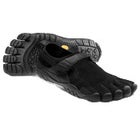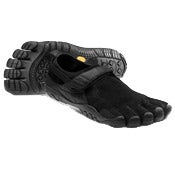Well, the thing is, Carlos, Unless your shoes are manifestly falling apart, you really CANT tell. Most trail runners have EVA midsolesthats the part that does most of the cushioning. And EVA can lose much of its ability to absorb shock before it looks or feels all that different.
 The Five Fingers
The Five FingersMy own rule of thumb: If you are a regular runner, putting in 20 or so miles a week, them once every six months is not too often to replace them. Thats even if they look to be in otherwise good shape. My other rule of thumb: Its better to buy mid-priced trail runners (under $100) and be willing to replace them, than it is to buy more expensive models that you are reluctant to get ditch.
Good choices: Mountain Masochists ($95), which are nice, light shoes with enough protection and toughness for trailers. Excellent in warm weather. XA Comp 4s ($100) are another example of a good-quality shoe that wont set you back too much.
Personally, I am fascinated by the growing debate over whether it even makes sense to WEAR running shoes or trail runners. I find some merit to the argument that with all the technology not found in running shoes, running injuries should have been eliminated. But they remain common. I certainly find it plausible that the body adopts its own low-shock way of running, then artificial cushioning is taken away. And it is interesting to see sales of Five Fingers ($75) take off as runners seek something that creates a more “natural” running feel while still offering some protection. Maybe you should try some of those!


